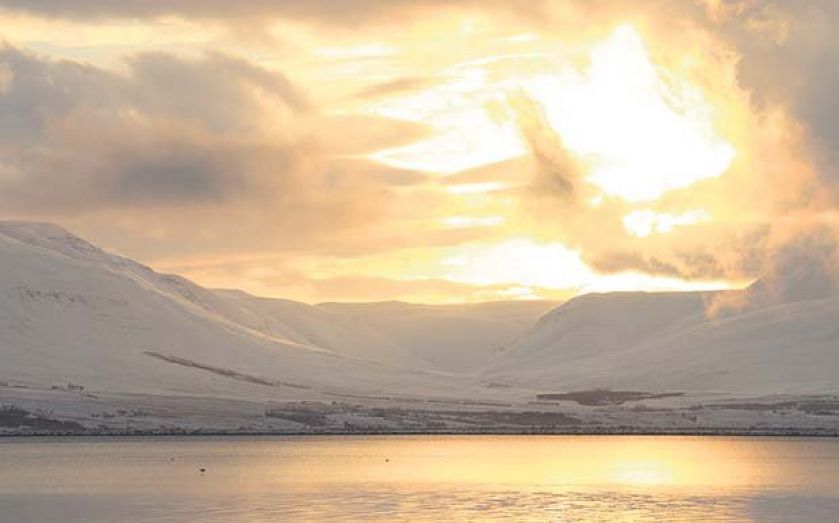Iceland: the world’s most dramatic landscapes

There may only be one proper city in Iceland, but with geysers, volcanic caves, and grinding tectonic plates, there’s plenty to sink your teeth into
YOU WILL get lost in Iceland: not geographically, but inside your head. It’s easy to get disorientated when stepping out in swimming gear, exposing your vulnerable flesh to temperatures well below zero, and then slipping into a warm lagoon of geothermal water. Thankfully the onset of panic is assuaged by a gulp of wine you can take in with you. Then snow starts to spiral down – unsurprisingly: the Arctic Circle is only 100km to the north.
This is Nature Baths in the Myvatn region of North Iceland and it knocks the socks off the famous Blue Lagoon that everyone visits outside Reykjavik. There you feel like a tourist on show, the human equivalent of one more ungainly penguin in a penguin parade. When I dipped into the baths at Myvatn late on a Friday night it would have been empty were it not for some local lads winding down for the weekend by soaking in the mineral-rich waters with a couple of beers.
The Myvatn region, easy to access with a hired car or on a jeep tour, brings you up close to Iceland’s contradictory extremes: hostile (environment) yet hospitable (people), almost crime-free (the country’s single high-security prison has all of 80 convicts) but callous (whales are hunted and eaten).
Most extreme is the landscape. It’s like a live 3D nature documentary: volcanic caves, pseudocraters that outside of Iceland are only found on Mars, lava fields, geysers, giant waterfalls, fumaroles and fissures, tectonic plates grinding together as they force apart the planet’s surface by up to 18mm each year. For pure derring-do fun there is snowmobiling from the Sel Hotel; racing across the dazzling white landscape is as close as it gets to being in a James Bond movie. And for a wacky food experience it is hard to beat the restaurant Vogafjós, located inside a cowshed and separated from animals by Perspex glass. The menu’s beef, lamb, mozzarella, rye bread (baked in a geothermally heated hole in the ground) and ice-cream all come from the farm and you can enjoy a cocktail while watching the cows being milked.
Akureyri, a forty-minute flight from Reykjavik, is the ideal base for exploring north Iceland. With 20,000 inhabitants, this is the country’s second-largest city but it looks like a desolate frontier town on the edge of nowhere. Thank goodness for creature comforts such as the smart, Scandinavian-style Icelandair hotel, with a happy hour at the bar and free entrance to an open-air, heated swimming pool across the road. A pre-breakfast swim and a soak in the hot tub is bracing, especially when it’s still dark (the pool opens at 6.45am). Good food is never far away: Greifinn restaurant with its humarsúpa (baby lobster soup) is excellent and so is the timber-roofed Rub23 for sushi, steak or a minke whale starter for the ecologically indifferent.
A spectacular road trip to Akureyri and back provides breathtaking views of the ex-herring-fishing capital of Iceland. This is the stark and lonely-looking Siglufjörður, once home to a workforce of 10,000 until overfishing crippled the industry and reduced the population to 1,200. The best skiing in Iceland is here and in summer there are bracing walks across the hillsides. The road back to Akureyri passes through Dalvik where, from June to early August, a daily ferry departs for the island of Grímsey and the Arctic Circle.
What about Reykjavik then? Iceland’s only proper city is best at the weekend when the bars and clubs are in full swing. For after-hours eating grab a pylsa (hot dog) from a street vendor. The famous one near the Radisson Blu 1919 hotel still has a queue at 4am on a Sunday morning. For more formal dining, Dill excels in Nordic-cool cuisine while Uno has a menu that mixes Italian favourites with Icelandic classics like fish and chips and lamb shank.
Tour companies abound in Reykjavik. The unfounded optimism with which some of them promise a glimpse of the Northern Lights made me wonder if the dodgy talent in the country’s ex-banking business has diverted to sectors of the tourist industry. “Golden Circle” trips, on the other hand, do deliver the big sights: Gullfoss, a magnificent geyser where water explodes vertically out of the ground (up to 30 metres); and Þingvellir where a rift valley marks the collision of continental plates – it’s a long way from dreary high school geography lessons.
Need to know
GETTING THERE
Aerlingus.com fly daily from Belfast to Gatwick from £26 one way, including taxes; WOW air wowair.co.uk fly 13 times a week from London Gatwick to Reykjavik direct from £74 one way, including taxes.
Activities: Myvtan Nature Baths jardbodin.is £14 entrance; IceAk, iceak.is, family-run, Akureyri-based concern with 2/3/8/15-hour jeep tours for £50/95/140/270; snowmobile tours myvatn.is around Lake Myvtan £64-84 per person; ferry from Dalvik to Grímsey £43 return (flight from Akureyri £127), bus from Akureyri to Dalvik £7.50; “Golden Circle” tours, 8+ hours with Superjeep www.superjeep.is £180, Northern Lights £100.
Accommodation: Icelandair Akureyri Hotel icelandairhotels.com rooms from £60 (low season)
Restaurants: Greifinn www.greifinn.is lunch £10; 200gm steak £15; Rub23 rub23.is tasting menus from £35 to £45, wine from £32; Vogafjós vogafjos.net main courses from £18, lunch £11, cocktails £10; wine-accompanied meals at Dill dillrestaurant.is from £42; three courses at Uno around £30 and wine from £26.
Information: tourist information: visiticeland.com and northiceland.is; guide book Iceland (Lonely Planet, 2013); travelogue Iceland Defrosted by Edward Hancox (Silverwood, 2013).